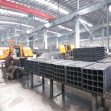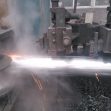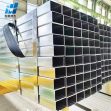Debonding Detection in Hidden Frame Supported Glass Curtain Wall
Hidden frame glass curtain wall has been widely used in the building construction due to its dexterity, lightness, transparency and structural beauty. It provides all the required functions of an external enclosure and decorative structure, which usually do not contribute to the load-bearing ability. The glass plate of the hidden frame supported glass curtain wall is directly bonded to the aluminum alloy sub-frame by silicone structural adhesive. However, there is inevitable to have certain problems with the service life of the hidden frame supported glass curtain wall over time. Because of the effects of long-term thermal stress and environmental aging, hidden frame supported glass curtain walls inevitably suffer from defects such as cracks, bubbles, lamination and debonding defects.

Debonding defect is one of the common problems for most of curtain wall facades and they are the main reason for the failure of hidden frame supported glass curtain walls, which are widely used as an external enclosure and decorative structure. Once there is a debonding defect, it may cause the curtain wall glass to fall off, which may lead to accidents and heavy property losses. Therefore, there is a great need to develop an effective method for debonding detection in hidden frame supported glass curtain walls. Fortunately, there are a few methods to be proposed for debonding detection in hidden frame supported glass curtain walls nowadays. The commonly used detection methods are suction cup and balloon methods which apply exerted pressure on the glass by a suction cup or balloon to simulate wind load. The stress and displacement are used to evaluate the quality of the glass curtain wall. However, before testing, the balloon or mechanical devices must be installed to apply the appropriate load which leads to low efficiency.
At the same time, various ultrasonic testing methods have been proposed for detecting debonding defects, like ultrasonic scanning and ultrasonic guided waves. In practical applications, the ultrasonic scanning method is highly dependent on the testing equipment to realize the scanning function, while the ultrasonic guided wave method has been effective for detecting large defects. Furthermore, nonlinear ultrasonic guided wave method has attracted significant attention because it has the advantage of sensitivity to small defects. Nonlinear ultrasonic guided wave methods can be divided into the nonlinear harmonic and the nonlinear ultrasonic modulation method. However, the detection result of nonlinear harmonic method is also affected by the instruments’ nonlinearity, which means the results may not exactly reflect the defects state. Unlike the nonlinear harmonic method, the detection result of the nonlinear ultrasonic modulation method is not affected by the instruments’ nonlinearity.
Tel: +86 18202256900 Email: steel@fwssteel.com










